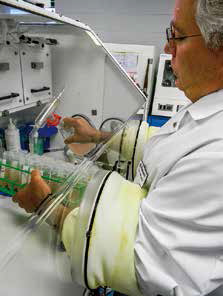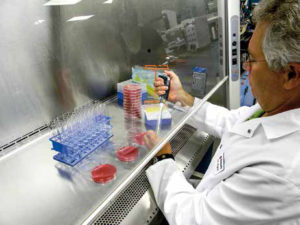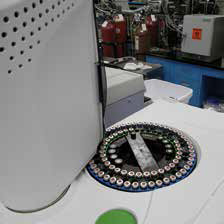
Tom Weigand, M.S., Fermentation Scientist, Diamond V
By Tom Weigand, M.S., Fermentation
Scientists at DIAMOND V began developing the Intestinal Activity Modifier Model (IAMM) in 2007. Working at the Research and Innovation Center (RIC) on the campus of Kirkwood College in Cedar Rapids, Iowa, USA, they built on the science and technology developed for their successful Rumen Activity Modifier Model (RAMM).
The goal of both models is to mimic anaerobic fermentation and other microbiological activity in vitro – in the lab, not in animals — and thereby control for critical variables that affect the gut environment. Such models are a great advantage in isolating and studying the effects of existing Diamond V products as well as new prototypes.
For example, Original XPC™ had wellproven beneficial effects in ruminants, like dairy cows and  beef cattle. But it also had beneficial effects in monogastrics, Chairman John Bloomhall, who was then President and CEO, got the IAMM project going by asking, “Why?”
beef cattle. But it also had beneficial effects in monogastrics, Chairman John Bloomhall, who was then President and CEO, got the IAMM project going by asking, “Why?”
Today, we use IAMM in many iterations to accurately simulate anaerobic fermentation in the hindgut – cecum plus large intestine – and control most variables affecting the experiment. Lab experiments in micro fermentation arrays make test replication and screening much quicker and cost-effective than trying to do the same work in animals. IAMM also helps in the design of follow-up in vivo studies and accelerates product research and development. In addition, the IAMM assay is a valuable tool for quality control and assurance during manufacture of Diamond V products.
How IAMM works
Gut microbial populations are complex and dynamic. They include hundreds of species of commensal and pathogenic chickens and pigs. Diamond V bacteria in proportions that change with an animal’s age and many other factors. For this reason, IAMM uses fecal material that matches the study animal as closely as possible. For example, we use layer feces — not broiler feces — to produce the inoculum used in a layer IAMM trial. Likewise, turkey feces are used for turkey IAMM modeling, and, for swine, we use fecal inocula from pigs of the targeted body weight range.
Also in IAMM, we blend feedstuffs to approximate the target animal’s typical diet. For example,  various blends of corn, soybean meal, DDGS (dried distiller grains with solubles), wheat, etc. can be tested. This is a very useful component of the assay as it allows the testing of Diamond V products in diets that more closely match specific markets for poultry and swine.
various blends of corn, soybean meal, DDGS (dried distiller grains with solubles), wheat, etc. can be tested. This is a very useful component of the assay as it allows the testing of Diamond V products in diets that more closely match specific markets for poultry and swine.
It is important to emphasize that IAMM is not a digestion assay. Rather than evaluating digestion or absorption of nutrients from the diet, IAMM evaluates the effect of a product or products on production of volatile fatty acids (VFA). The control or experimental diet itself is pre-digested using hydrochloric acid, pepsin, and pancreatin to simulate the effects of the stomach and small intestine. However, In the 24-hour IAMM test, we mix the pre-digested diet, fecal inocula, and test product in special test tubes under anaerobic conditions. Only about 10% of monogastric gut organisms can survive outside the gut – most are anaerobic and require a low or zero oxygen environment.
So, we use one of the anaerobic chambers or “glove boxes” in the RIC lab, which is a Biosafety Level 2 facility.
Butyrate discovery
In the early stages of IAMM development, we noticed that Original XPC stimulated VFA production, much like that observed in the rumen activity modifier model. In RAMM, there was preferential stimulation of production of the VFA propionate. However, in IAMM, Original XPC preferentially stimulated the production of another important VFA — butyrate.
 Ruminal VFA production is the major source of energy pre-cursors for ruminants. In monogastrics, hindgut VFA production provides some energy for larger pigs and sows, but very little for young pigs or poultry. Yet an increase in butyrate production by commensal gut bacteria in monogastrics opens the way to new ways to support animal health and production.
Ruminal VFA production is the major source of energy pre-cursors for ruminants. In monogastrics, hindgut VFA production provides some energy for larger pigs and sows, but very little for young pigs or poultry. Yet an increase in butyrate production by commensal gut bacteria in monogastrics opens the way to new ways to support animal health and production.
The IAMM discovery of preferential butyrate production has generated much new Diamond V research in the areas of immune support and pre-harvest food safety.
Limitations
Although IAMM is sensitive enough to show differences in product inclusion rates, it is not yet sensitive enough to test normal or physiological inclusion rates of products in a diet.
Another limitation of IAMM is the proprietary blend of ingredients in the matrix used to process our products. For this reason, it usually is not possible to directly compare competing products using IAMM.
Nonetheless, IAMM is especially useful in comparing Diamond V’s existing and potential new products during development, so long as these products are produced using the same ingredient matrix. This approach lets us make a more direct comparison of the resulting unique fermentation metabolites, which are the “active ingredients” in Diamond V nutritional health products.
Keep in mind…
Ask your Diamond V representative for more information about IAMM so you
can:
• Understand the model – IAMM simulates hindgut fermentation;
• Understand its limitations, particularly that test products are not digested, that there may be ingredient matrix interactions, and that IAMM does not provide information on immune function or intestinal morphology; and,
• Know what each test is measuring and avoid over-interpretation of results trying to predict in vivo responses. n
Learn more about Diamond V research and development through your Diamond V representative or the Asia office in Bangkok, Thailand (phone +66.2652.6890, email dvasia@diamondv.com).
